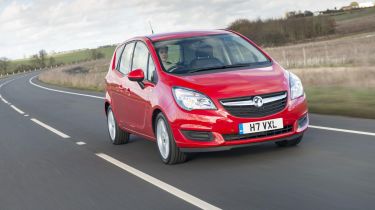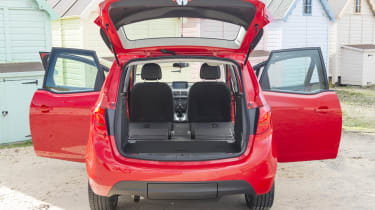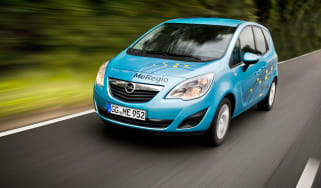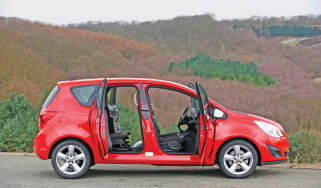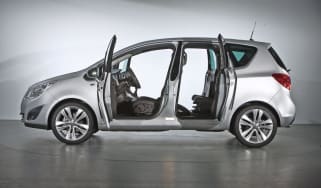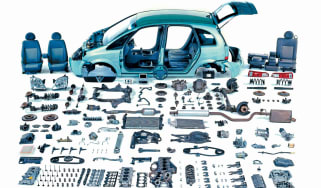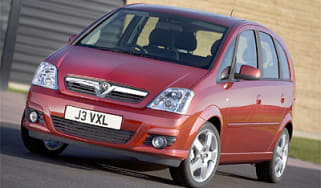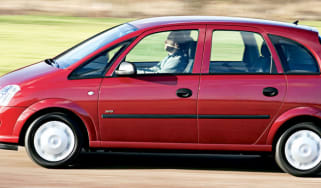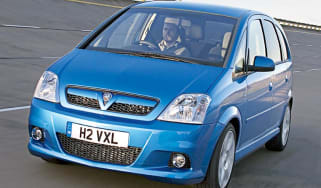Vauxhall Meriva (2014-2017) review
The innovative Vauxhall Meriva offers family-friendly transport thanks to its versatile seating and wide-opening doors
The Meriva compact MPV’s stand-out feature is a novel rearwards-opening rear passenger door set-up. It is reasonably effective, but it doesn’t create as wide an opening as the sliding side doors used on the Ford B-MAX.
On the plus side, the Meriva features an upmarket cabin that features plenty of soft touch materials and is robustly constructed. It’s practical, too.
The Meriva also offers a reasonably grown-up driving experience. Composed handling and decent refinement give the little Vauxhall a bigger car feel, while the supple ride does a good job of soaking up bumps. But the engine range is disappointing, with dated petrol units and some noisy diesels.
The Vauxhall Meriva is a supermini-based MPV that’s designed to rival practical models such as the Ford B-MAX and Nissan Note. At the heart of the Vauxhall’s appeal are its novel ‘suicide’ rear-hinged back doors that have been added to boost access.
This is the second-generation Meriva, and it’s already been around long enough to have seen a facelift in 2014. In fact the Meriva B (to give it its full name) first went into production in 2010 at GM’s factory at Zaragoza in Spain.
The current car is a little larger than the first generation Meriva sold from 2003 to 2010, which was based on the contemporary Corsa platform. This car was developed from a new platform based on the larger Zafira’s underpinnings, but with suspension re-engineered from the older Meriva.
The Meriva has an interior that shares much in common with the 2009 Astra. It majors on practicality in spite of its compact dimensions, with a rear bench that slides to improve legroom or boost boot space. Also, the individual rear seats can be moved together or pulled apart to create four or five-seat layouts. Elsewhere there’s a neat Flex-rail system that runs between the front seats and can be configured to hold extra storage and cupholders.
The engine line-up is less impressive. The 1.4-litre petrol units are getting on a bit and trial the best in class when it comes to running costs, while the 1.7-litre CDTi diesel is noisy and sluggish. Best of the bunch is the recently introduced 1.6-litre CDTi that combines smooth and punchy performance with decent fuel economy.
As with other Vauxhall models, the Meriva suffers from an extremely confusing model line-up – buyers can choose from Life, S, Exclusiv, Energy, Tech Line and SE trim levels. Some are aimed at private buyers, while the others are intended to appeal to company car users.
All versions get air-conditioning, electric windows and central locking. However, the Life, which undercuts the equivalent S by nearly £4,000, adds alloy wheels, Bluetooth connectivity, cruise control and a leather steering wheel to this tally. A panoramic sunroof is a feature of top spec versions.
Engines, performance and drive
Jump behind the wheel of the Meriva and prepare to be pleasantly surprised – it actually drives rather well, despite a tall body that looks as if it’s going to lean into bends too much, but doesn’t.
On winding roads, the Meriva demonstrates good handling thanks to the blend of well-weighted steering, strong grip and good body control, which all add up to plenty of agility.
Even on the UK’s rougher road surfaces, the car is still reasonably comfortable, with supple suspension soaking up bumps easily. Refinement is strong, too. Road noise is particularly well suppressed, which helps to make long motorway journeys a breeze – although some of the older diesel engines are a little intrusive.
Engines
The Vauxhall Meriva has been around a while now, and that’s reflected in its ageing engine line-up.
The entry-level 99bhp 1.4-litre petrol struggles with the Meriva’s bulk and offers a 0-62mph figure of 14.0 seconds. The 118bhp turbo is only a little better – it’s quiet at cruising speeds, but with only 175Nm of torque it needs to be worked hard to make the most of the performance. Vauxhall claims 0-62mph in a leisurely 11.3 seconds.
The 138bhp petrol version is better, but never feels as muscular as its power figure suggests.
Diesel fans are better catered for, thanks to the introduction of Vauxhall’s new 1.6-litre CDTi unit. It’s available in 94bhp, 108bhp and 134bhp guises and is a smooth and punchy performer. It’s remarkably efficient, too.
Less impressive are the 1.3-litre and 1.7-litre CDTi units. The former musters just 74bhp and carries the Meriva from 0-62mph in a glacial 16.9 seconds, while the latter is clattery and unrefined – although it’s only available with a six-speed automatic transmission. All other models get a positive five speed manual, apart from the 138bhp 1.4 Turbo and all 1.6 CDTi versions, which get a six-speed unit.
MPG, CO2 and Running Costs
Given its supermini roots, you’d expect the Vauxhall Meriva to deliver penny-pinching running costs. Yet while the day-to-day running costs of the most efficient models should be impressively low, the sad fact is that the Vauxhall is hobbled by its high prices and steep depreciation.
Rivals such as the Kia Venga and Hyundai ix20 make the Meriva look expensive up front, and while the entry-level Meriva Life looks like good value on paper, it’s only available with the weedy 98bhp 1.4-litre petrol engine.
The Tech Line trim level also looks attractive on paper, but it’s not available with the handy Flexrail system – you can’t even add it as an option.
At least the Meriva’s engine range is – in the main – efficient, with the recently introduced 1.6-litre CDTi in particular delivering strong economy and low CO2 emissions, partly thanks to its Start/Stop technology.
Best of the bunch is the 108bhp version, which claims 74.3mpg and 99g/km of CO2, resulting in competitive company car benefit-in-kind rates.
The most expensive choice for running costs is the 118bhp 1.4-litre petrol turbo when equipped with a six-speed automatic gearbox. This suffers from official fuel consumption of 39.8mpg and CO2 emissions of 166g/km. The version with five- speed manual gears does a little better with 47.9mpg and 139g/km. With the SE trim, this is our recommended model.
Insurance groups
There's quite a range of insurance groups for the various Meriva models, with the cheapest petrol engine in group 9 and the most powerful diesel engines up in group 16 or 17. Across the board, ratings seem to be a little higher than the Ford B-Max and Hyundai ix20.
Depreciation
If you’ve just bought a Meriva, look away now…
The brutal truth is that Vauxhalls are unloved on the second hand market, which is not so much a comment on their running costs and reliability, but more a reflection of the brand’s lack of aspirational appeal.
This makes the Meriva a great second-hand buy, but the predicted 30 per cent residual value after three years and 36,000 miles is going to sting if you’re a private owner. Ford’s B-Max will keep 40 per cent of its original value over the same period.
To get an accurate valuation on a specific model check out our free car valuation tool...
Interior, design and technology
Given that it’s a practical, family-friendly run-around, the Meriva is surprisingly stylish. Its swept-back headlamps and chrome grille take their cues from the larger Insignia, while distinctive character lines have been cut into the car’s flanks.
Though it's neatly styled, the high roofline and double door arrangement take centre stage. The rear-hinged back doors have been designed to improve access to the cabin, but the B-pillar (the one between the doors) remains in place so the advantage over a standard set-up is small.
Inside, the Meriva benefits from an upmarket look and feel. Decent quality plastics are used throughout, while the fit and finish is excellent. Yet while the dashboard is slickly designed, the centre console is cluttered with a confusing array of buttons.
As with other models there’s a wide range of trim levels to choose from, although the line-up is hugely confusing. Vauxhall has attempted to tailor individual models to private buyers and business users, but the end result is massively overcomplicated.
Essentially you can choose from Life, S, Exclusiv, Energy, Tech line and SE trims, and all get air-con, electric windows and central locking. However, Life models get more kit than S versions, despite costing far less, while the Tech Line models undercut the Exclusiv on price, but come loaded with executive car levels of kit.
Sat-nav, stereo and infotainment
The Meriva S comes as standard with a radio, but Life models and upwards are also fitted with a CD player and Bluetooth connectivity for your smartphone, as well as steering wheel controls for audio.
A digital radio is optional across the line-up, as are two levels of sat-nav installation called Navi 650 or Navi 950. Both feature a seven-inch screen at the top of the dash, as well as a USB connector for your iPod. The Navi 950 version also includes the IntelliLink system, which connects your smartphone to the car. It also has voice recognition for destination entries, but there’s no internet access for social media apps or email.
Practicality, comfort and boot space
There’s plenty of space up front in the Meriva, while the high set driver’s offers a commanding view of the road ahead. There’s also plenty of seat and wheel adjustment – although S and Exclusive models suffer from a cheap-feeling plastic steering wheel – and the seats themselves are comfortable and supportive on long journeys.
The main controls are predictably laid out, but the confusing array of buttons on the centre console can be distracting as you have to take your eye off the road for too long while working out the functions.
Elsewhere in the cabin, there are lots of useful storage drawers and spaces, including door pockets big enough to hold a one-litre drinks bottle upright.
Vauxhall also offers the FlexRail in Exclusiv and SE equipped cars. This consists of a pair of rails that run the entire length of the cabin, onto which a variety of movable and secure stowage bins can be fixed – Vauxhall reckons there are 32 different configurations, which should keep the kids happy for hours.
Dimensions and size
Although the Meriva is relatively stylish to look at, it’s still a relatively boxy MPV configuration with a tall stance on the road. It’s 4,300mm long, 1,812mm wide and 1,615mm tall, so it's usefully larger than the Ford B-Max, which is 4,077mm x 1,751mm x 1,604mm.
Leg room, head room & passenger space
The unusual rear-opening back doors make access to the Meriva’s back seats extremely easy, and even strapping-in child seats is a breeze. There are robust grab handles to ensure you can reach both sides of the rear bench without having to clamber over seats, too. That said, the door arrangement isn’t quite as useful in tight spaces as the B-Max’s sliding set-up.
The Meriva's FlexSpace seating arrangement allows you to slide the rear bench forward and backwards. You can also fold the middle seat into an armrest, and then push the chairs inwards to switch from a five-seater into a more spacious four-seater with much-improved shoulder room.
Boot space
The Vauxhall Meriva has a spacious 397-litre boot with an underfloor compartment, which means it's 100 litres bigger than the Corsa supermini.
The seats also fold completely flat to create an enormous 1,500-litre load space that's 1.75 meters long, and the wide and square tailgate makes loading easy.
Reliability and Safety
Vauxhall knows a thing or two about building reliable, safe cars, so the fact that the Meriva offers a five-star EuroNCAP test result should come as no surprise. However, only four airbags are fitted as standard, with only Exclusiv, Tech Line and SE models getting additional curtain airbags – you can add these desirable extras to other models for £460.
Elsewhere you’ll benefit from electronic stability control, adaptive brake lights that flash during heavy braking, ISOFIX child seat mounting points and hill-start assist. However, unlike newer rivals there’s no option to add blind spot monitoring, lane keep assist or autonomous emergency braking.
The EuroNCAP crash-test ratings were 89 per cent for adult occupants, 77 per cent for children, and 55 per cent for pedestrians. Equivalent scores for the Ford B-Max were 92 per cent, 84 per cent and 67 per cent, while the Hyundai ix20 managed 89 per cent, 85 per cent and 64 per cent – they’re both 5 star cars too.
While safety is fully covered, we’re not quite so confident in the Meriva’s reliability, having witnessed its poor performance in the latest Driver Power 2015 survey. Out of 200 cars surveyed, the Meriva came in 186th overall for customer satisfaction, and its 156th for reliability and 163rd for build quality weren’t much better either.
The overall manufacturer/brand ratings don’t paint a better picture either, as Vauxhall ranked a poor 28th out of 32 manufacturers for reliability. For overall satisfaction, owners ranked Vauxhall an even worse 30th.
Warranty
The entire Vauxhall range comes with a standard three-year, 60,000-mile warranty – and it’s been looking a bit stingy for a while now. The Meriva is up against rivals such as the Kia Venga, which has seven-year cover, and the Hyundai ix20, which comes with five years.
Servicing
Vauxhall maintenance prices are pretty competitive, with fixed price servicing for the Meriva starting at £129. The manufacturer also has fixed prices for changing wear-and-tear bits and pieces, so we can tell you a new set of brake pads is £99, and a clutch replacement is £529.
